 UbuWeb | UbuWeb |  UbuWeb Papers UbuWeb PapersSynesthesia and Intersenses: Intermedia Dick Higgins with an Appendix by Hannah Higgins 1965, Originally published in Something Else Newsletter 1, No. 1 (Something Else Press, 1966). Also published as a chapter in Dick Higgins, Horizons, the Poetics and Theory of the Intermedia (Carbondale, IL: Southern Illinois Univ. Press, 1984).
RELATED RESOURCES:
 Dick Higgins' Audio Works on UbuWeb Sound Poetry Dick Higgins' Audio Works on UbuWeb Sound Poetry
 Dick Higgins' Visual Works in UbuWeb Historical Dick Higgins' Visual Works in UbuWeb Historical
Much of the best work being produced today seems to fall between media. This is no accident. The concept of the separation between media arose in the Renaissance. The idea that a painting is made of paint on canvas or that a sculpture should not be painted seems characteristic of the kind of social thought--categorizing and dividing society into nobility with its various subdivisions, untitled gentry, artisans, serfs and landless workers--which we call the feudal conception of the Great Chain of Being. This essentially mechanistic approach continued to be relevant throughout the first two industrial revolutions, just concluded, and into the present era of automation, which constitutes, in fact, a third industrial revolution. However, the social problems that characterize our time, as opposed to the political ones, no longer allow a compartmentalized approach. We are approaching the dawn of a classless society, to which separation into rigid categories is absolutely irrelevant. This shift does not relate more to East than West or vice versa. Castro works in the cane fields. New York's Mayor Lindsay walks to work during the subway strike. The millionaires eat their lunches at Horn and Hardart's. This sort of populism is a growing tendency rather than a shrinking one. We sense this in viewing art which seems to belong unnecessarily rigidly to one or another form. We view paintings. What are they, after all? Expensive, handmade objects, intended to ornament the walls of the rich or, through their (or their government's) munificence, to be shared with large numbers of people and give them a sense of grandeur. But they do not allow of any sense of dialogue. Pop art? How could it play a part in the art of the future? It is bland. It is pure. It uses elements of common life without comment, and so, by accepting the misery of this life and its aridity so mutely, it condones them. Pop and op are both dead, however, because they confine themselves, through the media which they employ, to the older functions of art, of decorating and suggesting grandeur, whatever the detailed content of their artist's intentions. None of the ingenious theories of the Mr. Ivan Geldoway combine can prevent them from being colossally boring and irrelevant. Milord runs his Mad Avenue Gallery, in which he displays wares. He is protected by a handful of rude footmen who seem to feel that this is the way Life will always be. At his beck and call is Sir Fretful Callous, a moderately well-informed high priest, who apparently despises the Flame he is supposed to tend and therefore prefers anything which titillates him. However, Milord needs his services, since he, poor thing, hasn't the time or the energy to contribute more than his name and perhaps his dollars; getting information and finding out what's going on are simply toooooo exhausting. So, well protected and advised, he goes blissfully through the streets in proper Louis XIV style. This scene is not just characteristic of the painting world as an institution, however. It is absolutely natural to (and inevitable in) the concept of the pure medium, the painting or precious object of any kind. That is the way such objects are marketed since that is the world to which they belong and to which they relate. The sense of "I am the state," however, will shortly be replaced by "After me the deluge," and, in fact, if the High Art world were better informed, it would realize that the deluge has already begun. Who knows when it began? There is no reason for us to go into history in any detail. Part of the reason that Duchamp's objects are fascinating while Picasso's voice is fading is that the Duchamp pieces are truly between media, between sculpture and something else, while a Picasso is readily classifiable as a painted ornament. Similarly, by invading the land between collage and photography, the German John Heartfield produced what are probably the greatest graphics of our century, surely the most powerful political art that has been done to date. The ready-made or found object, in a sense an intermedium since it was not intended to conform to the pure medium, usually suggests this, and therefore suggests a location in the field between the general area of art media and those of life media. However, at this time, the locations of this sort are relatively unexplored, as compared with media between the arts. I cannot, for example, name work which has consciously been placed in the intermedium between painting and shoes. The closest thing would seem to be the sculpture of Claes Oldenburg, which falls between sculpture and hamburgers or Eskimo Pies, yet it is not the sources of these images themselves. An Oldenburg Eskimo Pie may look something like an Eskimo Pie, yet is neither edible nor cold. There is still a great deal to be done in this direction in the way of opening up aesthetically rewarding possibilities. In the middle 1950s many painters began to realize the fundamental irrelevance of abstract expressionism, which was the dominant mode at the time. Such painters as Allan Kaprow and Robert Rauschenberg in the United States and Wolf Vostell in Germany turned to collage or, in the latter's case, dé-collage, in the sense of making work by adding or removing, replacing and substituting or altering components of a visual work. They began to include increasingly incongruous objects in their work. Rauschenberg called his constructions "combines" and went so far as to place a stuffed goat--spattered with paint and with a rubber tire around its neck--onto one. Kaprow, more philosophical and restless, meditated on the relationship of the spectator and the work. He put mirrors into his things so the spectator could feel included in them. That wasn't physical enough, so he made enveloping collages which surrounded the spectator. These he called "environments." Finally, in the spring of 1958, he began to include live people as part of the collage, and this he called a "happening." The proscenium theater is the outgrowth of seventeenth-century ideals of social order. Yet there is remarkably little structural difference between the dramas of Davenant and those of Edward Albee, certainly nothing comparable to the difference in pump construction or means of mass transportation. It would seem that the technological and social implications of the first two industrial revolutions have been evaded completely. The drama is still mechanistically divided: there are performers, production people, a separate audience and an explicit script. Once started, like Frankenstein's monster, the course of affairs is unalterable, perhaps damned by its inability to reflect its surroundings. With our populistic mentality today, it is difficult to attach importance--other than what we have been taught to attach--to this traditional theater. Nor do minor innovations do more than provide dinner conversation: this theater is round instead of square, in that one the stage revolves, here the play is relatively senseless and whimsical (Pinter is, after all, our modern J.M. Barrie--unless the honor belongs more properly to Beckett). Every year fewer attend the professional Broadway theaters. The shows get sillier and sillier, showing the producers' estimate of our mentality (or is it their own that is revealed?). Even the best of the traditional theater is no longer found on Broadway but at the Judson Memorial Church, some miles away. Yet our theater schools grind out thousands on thousands of performing and production personnel, for whom jobs will simply not exist in 20 years. Can we blame the unions? Or rents and real estate taxes? Of course not. The subsidized productions, sponsored at such museums as New York's Lincoln Center, are not building up a new audience so much as recultivating an old one, since the medium of such drama seems weird and artificial in our new social milieu. We need more portability and flexibility, and this the traditional theater cannot provide. It was made for Versailles and for the sedentary Milords, not for motorized life-demons who travel 600 miles a week. Versailles no longer speaks very loudly to us, since we think at 85 miles an hour. In the other direction, starting from the idea of theater itself, others such as myself declared war on the script as a set of sequential events. Improvisation was no help; performers merely acted in imitation of a script. So I began to work as if time and sequence could be utterly suspended, not by ignoring them (which would simply be illogical) but by systematically replacing them as structural elements with change. Lack of change would cause my pieces to stop. In 1958 I wrote a piece, Stacked Deck, in which any event can take place at any time, as long as its cue appears. The cues are produced by colored lights. Since the colored lights could be used wherever they were put and audience reactions were also cuing situations, the performance-audience separation was removed and a happening situation was established, though less visually oriented in its use of its environment and imagery. At the same time, Al Hansen moved into the area from graphic notation experiments, and Nam June Paik and Benjamin Patterson (both in Germany at the time) moved in from varieties of music in which specifically musical events were frequently replaced by nonmusical actions. Thus the happening developed as an intermedium, an uncharted land that lies between collage, music and the theater. It is not governed by rules; each work determines its own medium and form according to its needs. The concept itself is better understood by what it is not, rather than what it is. Approaching it, we are pioneers again, and shall continue to be so as long as there's plenty of elbow room and no neighbors around for a few miles. Of course, a concept like this is very disturbing to those whose mentality is compartmentalized. Time, Life, and the High Priests have been announcing the death of happenings regularly since the form gained momentum in the late fifties, but this says more about the accuracy of their information than about the liveliness of the form. We have noted the intermedia in the theater and in the visual arts, the happening, and certain varieties of physical constructions. For reasons of space we cannot take up here the intermedia between other areas. However, I would like to suggest that the use of intermedia is more or less universal throughout the fine arts, since continuity rather than categorization is the hallmark of our new mentality. There are parallels to the happening in music, for example in the work of such composers as Philip Corner and John Cage, who explore the intermedia between music and philosophy, or Joe Jones, whose self-playing musical instruments fall into the intermedium between music and sculpture. The constructed poems of Emmett Williams and Robert Filliou certainly constitute an intermedium between poetry and sculpture. Is it possible to speak of the use of intermedia as a huge and inclusive movement of which dada, futurism and surrealism are early phases preceding the huge ground swell that is taking place now? Or is it more reasonable to regard the use of intermedia as an irreversible historical innovation, more comparable, for example, to the development of instrumental music than, for example, to the development of romanticism?
1981In 1965, when the above words were written, the intention was simply to offer a means of ingress into works which already existed, the unfamiliarity of whose forms was such that many potential viewers, hearers, or readers were "turned off" by them. The world was filled at that time with concrete poems, happenings, sound poetry, environments, and other more or less novel developments; unless the public had a way of seeing into the work by causing it to stand still for a moment and be classified, the work was likely to be dismissed as "avant-garde: for specialists only." To any dedicated nonspecialist this could be frustrating--one wanted to know well the art of one's time, since one wanted to hear one's own voice or self at work, without the interventions of history and historical judgements; this was art whose horizons would closely match one's own. The vehicle I chose, the word "intermedia," appears in the writings of Samuel Taylor Coleridge in 1812 in exactly its contemporary sense--to define works which fall conceptually between media that are already known, and I had been using the term for several years in lectures and discussions before my little essay was written. Furthermore, as part of my campaign to popularize what was known as "avant-garde: for specialists only," to demystify it if you will, I had become a publisher of a small press, Something Else Press (1964-1974), which brought out editions of many primary sources and materials in the new arts (as well as reissuing works of the past which seemed to merit new attention--works by Gertrude Stein, the dadaists, the composer Henry Cowell, etc.). It seemed foolish simply to publish my little essay in some existing magazine, where it could be shelved or forgotten. So it was printed as the first Something Else Newsletter and sent to our customers, to all the people on our mailing list, to people to whom I felt the idea would be useful (for example, to artists doing what seemed to me to be intermedial work and to critics who might be in a position to discuss such work). All in all, I gave away some 10,000 copies of the essay, as many as I could afford; and I encouraged its republication by anyone who asked for permission to do so. It was reprinted seven or eight times that I knew of, and it still lives on in print in various books, not just of mine, but where it has been anthologized along with other texts of the time or as part of surveys. The term shortly acquired a life of its own, as I had hoped. In no way was it my private property. It was picked up; used and misused, often by confusion with the term "mixed media." This last is a venerable term from art criticism, which covers works executed in more than one medium, such as oil color and guache. But by extension it is also appropriate to such forms as the opera, where the music, the libretto, and the mise-en-scene are quite separate: at no time is the operagoer in doubt as to whether he is seeing the mise-en-scene, the stage spectacle, hearing the music, etc. Many fine works are being done in mixed media: paintings which incorporate poems within their visual fields, for instance. But one knows which is which. In intermedia, on the other hand, the visual element (painting) is fused conceptually with the words. We may have abstract calligraphy, concrete poetry, "visual poetry" (not any poem with a strong visual element, but the term is sometimes used to cover visual works in which some poem appears, often as a photography, or in which the photographed visual material is presented as a sequence with a grammar of its own, as if each visual element were a word of a sentence, as in certain works by Jean-François Bory or Duane Michaels). Again, the term is not prescriptive; it does not praise itself or present a model for doing either new or great works. It says only that intermedial works exist. Failure to understand this would lead to the kind of error of thinking that intermedia are necessarily dated in time by their nature, something rooted in the 1960s, like an art movement of the period. There was and could be no intermedial movement. Intermediality has always been a possibility since the most ancient times, and though some well-meaning commissar might try to legislate it away as formalistic and therefore antipopular, it remains a possibility wherever the desire to fuse two or more existing media exists. One can avoid it; one can be like Rosalind Krauss, a much respected critic who said in a lecture at Iowa City in 1981, "I am devoted to the idea of trying to bury the avant-garde," which she does by attacking it, ignoring it and its implications, or, even worse, presenting theory as such an end in itself that any sort of artwork becomes, at best, an unimportant appendage to the theory. But there is always an avant-garde, in the sense that someone, somewhere is always trying to do something which adds to the possibilities for everybody, and that that large everybody will some day follow this somebody and use whatever innovations were made as part of their workaday craft. "Avant-garde" is merely a conventional metaphor drawn (in the mid-nineteenth century) from the military, in which an avant-garde moves in advance of the main body of troops. "Avant-garde" is relative, not absolute. A conservative poet can be at least morally avant-garde by moving in the direction of ever-greater integrity and purity, of vividness or metaphor and excellence of line. Others seek to follow, even when they cannot; and thus the metaphor retains its relevance. But when one is thinking of the avant-garde of forms and media, one is often thinking of artists who, for whatever reason, question those forms and media. They can reject some (e.g., André Breton's predecessors in French dada rejected the novel, and they were avant-garde, while André Breton chose to move toward some kind of novel as a possibility, thus provoking a break between his group, which in due course became the surrealists, and the other--and the new group, too, was avant-garde). They can create others. And often this creation of new media is done by the fusion of old ones; this was very common in the late 1950s and early 1960s, with the formal fusions I have already mentioned. No work was ever good because of its intermediality [1]. The intermediality was merely a part of how a work was and is; recognizing it makes the work easier to classify, so that one can understand the work and its significances. Further, there is a tendency for intermedia to become media with familiarity. The visual novel is a pretty much recognizable form to us now. We have had many of them in the last 20 years. It is harping on an irrelevance to point to its older intermedial status between visual art and text; we want to know what this or that visual novel is about and how it works, and the intermediality is no longer needed to see these things. Same with visual poetry and sound poetry (or "text-sound," if one prefers that term). In the performance arts, once there was the happening which was close to "events"; some happenings artists did fluxus, and some did not. At least one fluxus artist, Alison Knowles, evolved in her work until she found herself doing what other new artists--many of whom took great pains to distinguish what they were doing from happenings, events, and fluxus--were calling, variously,""art performance" or "performance art." Where do we look for to find the continuity of these? To their intermediality: they are all the same intermedium, a conceptual fusion of scenario, visuality and, often enough, audio elements. But will the intermediality explain the uniqueness or value of the very best of art performance (or performance art)? I think not. Some works will become landmarks and will define their genre, while the others will be forgotten. At best the intermediality was needed to suggest their historical trajectory, to see their sometimes obscure pedigree (as one might use it, with happenings, to point toward the heritage of happenings from dada or futurist manifestations). But if the work is ever to become truly important to large numbers of people, it will be because the new medium allows for great significance, not simply because its formal nature assures it of relevance. This, then, is the caveat inherent in using the term intermedia: it allows for an ingress to a work which otherwise seems opaque and impenetrable, but once that ingress has been made it is no longer useful to harp upon the intermediality of a work. No reputable artist could be an intermedial artist for long--it would seem like an impediment, holding the artist back from fulfilling the needs of the work at hand, of creating horizons in the new era for the next generation of listeners and readers and beholders to match their own horizons too. What was helpful as a beginning would, if maintained, become an obsession which braked the flow into the work and its needs and potentials. One often regrets the adherence of an artist to a set of dogma: the "movement artist" is a case in point--he adheres to the teachings of his or her movement, long after these have passed their relevance. There is the "late" futurist, the "late" abstract expressionist, the "late" pop artist. To be late in that sense is somehow to create a sort of academicism, good for providing examples to a class ("Okay, class, now this week I want each of you to do a pop art painting"), perhaps useful for heuristic purposes but not likely to open up new horizons for the artist or his viewers, listeners, or readers.
And with this I would leave the matter of intermedia. It is today, as it
was in 1965, a useful way to approach some new work; one asks oneself,""what that I know does this new work lie between?" But it is more
useful at the outset of a critical process than at the later stages
of it. Perhaps I did not see that at the time, but it is clear to me
now. Perhaps, in all the excitement of what was, for me, a discovery, I
overvalued it. I do not wish to compensate with a second error of judgment
and to undervalue it now. But it would seem that to proceed further in
the understanding of any given work, one must look elsewhere--to all
the aspects of a work and not just to its formal origins, and at the
horizons which the work implies, to find an appropriate hermeneutic
process for seeing the whole of the work in my own relation to it.

Intermedia Higgins' "Intermedia Chart" resonates with temporally dynamic sociograms, where human interactions are highly differentiated and radically decentralized and based primarily on the specific needs of a given body, in this case artists. According to a model like this, historic and contemporary experience is diverse, causally flexible and permissive of the as-yet-unknown. The chart depicts intersections between fluxus and related work and makes no attempt at linear chronology. Fluid in form, the chart shows concentric and overlapping circles that appear to expand and contract in relationship to the "Intermedia" framework that encompasses them. It is an open framework that invites play. Its bubbles hover in space as opposed to being historically framed in the linear and specialized art/anti-art framework of the typical chronologies of avant-garde and modern art. 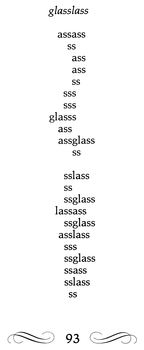
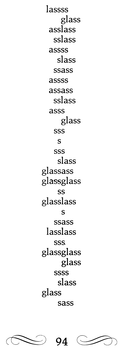
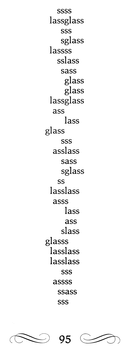
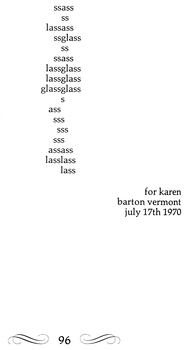
Glasslass ""Glasslass" (above) is a poem about slithering assonance and the naked page. The sounds of the esses slither, seemingly seamlessly surrounding the inside of the readers' mouths. Esses spill sexily across the page's soft skin, savoring the fancy glass lass. 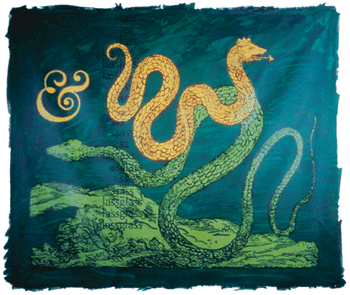
The Opaque and the Transparent For the last 20 years of his life, Higgins was, primarily, a scholar/painter. He extended his understanding of intermedia toward the past in the form of historic writings on George Herbert's pattern poems (1977), a translation of Novalis (1978, 1984), a history of Pattern Poetry (1987) and a book on Giordano Bruno (with Charles Doria, 1991). These scholarly pursuits constitute the historic basis of what he explored through the interdisciplinary and exhaustive sequence of paintings that include The Opaque and the Transparent (above). In one catalog, Daniel Charles called this the "logical and coherent" outcome of Higgins' work. As intermedia objects, these paintings belong equally to the graphic arts, poetry, music and performance. In this image, looking at and looking through are juxtaposed as a reflective resonance that constitutes a fragment and a whole simultaneously. Typical of his work generally, this image reforms its seemingly iconoclastic aims by reconstituting fragments as productive of a humanistic sense of the unity of every time, place and modality. 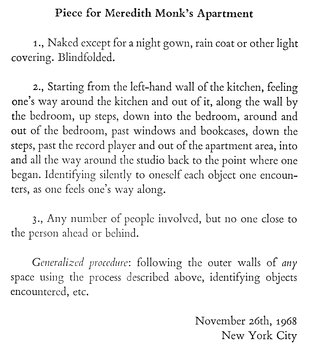
Piece for Meredith Monk's Apartment My father and Meredith Monk were dear friends who greatly admired each other's work and occasionally performed together in the middle and late 1960s. As a child I remember taking lessons at Meredith's studio. I include Piece for Meredith Monk's Apartment here (above) because, when they saw each other at the Walker in 1998, there was so much love between them that they just sat and smiled at each other for some minutes. That is, I think, a big part of why artists dedicate works to each other.  top top
|